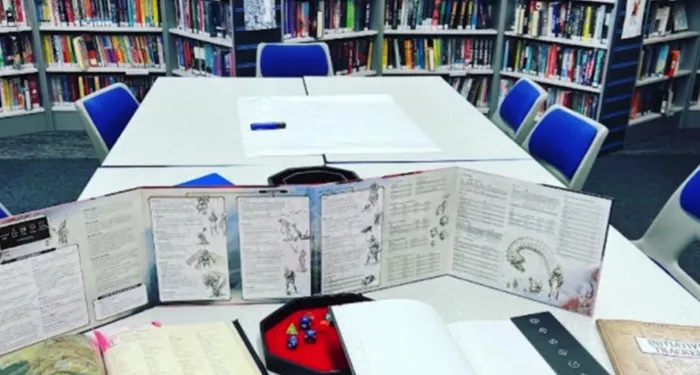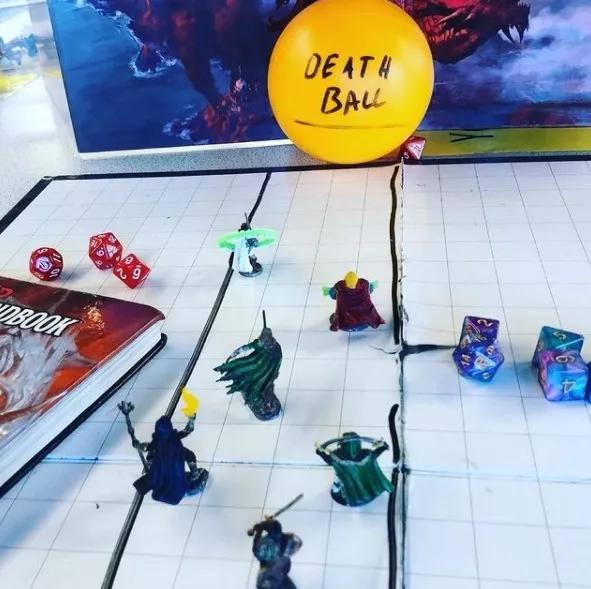
How to Introduce Dungeons and Dragons in Your Library
It’s no secret that I really love talking about Dungeons and Dragons. It’s been a huge part of my life for a few years now, and I’m very lucky to have found other people with similar interests. I really owe my love for D&D to the high school students who I work with in the school library I manage. They are the ones who reminded me of how much I love the world of D&D and everything about it. This has culminated in a lot of amazing opportunities: I’ve written a book on it and was even a guest on the official D&D podcast! Bringing it to the school was relatively easy, but what I want to focus on in the future is bringing it to more people in the school through focused classes, workshops, and lessons.
This will not be easy, but there are ways to do it. Your biggest enemy working in schools, in my opinion, is time and the large number of students you are working with. D&D takes a long time to run and works better in smaller groups. I’m going to discuss a few ways to bring D&D to your school or library on a bigger scale to ensure as many people can take part as possible.
To start, I really recommend the Starter Kit; it has everything you need, including character sheets and an awesome adventure.

Talk to Your Coworkers
This is a very important aspect of bringing Dungeons and Dragons to your school, in my opinion. When I started the D&D club in the library over five years ago, I assumed that no one in the school knew or cared about it. I was really wrong. Simply discussing and promoting the club to other staff members started a whole new ball rolling. Tons of teachers either played the game when they were younger and wanted to find out more or had heard about the game and wanted to start playing. This prompted me to start playing just with teachers as a form of professional well-being sessions. They were a huge hit, and I’m going to continue these in the future. You might also find that other staff members want to help your club out, have resources you can borrow, or will just be a listening ear if you need help or advice.
Run Your Own Convention
This might seem like a daunting task, but in my view, it’s one of the best ways to bring Dungeons and Dragons to a large-scale audience. It’s not as hard as you think, either; you simply need to carve out enough time to do it. I put aside four hours and held it on a Saturday because that was a day that worked for me. I had three teachers come and help out. Over 50 students arrived, some of them dressed up as fantasy characters! The idea is very simple: have food, have music, and have a few prizes (everyone who showed up got a free d20 dice). Have students sign up in advance, put them into groups of 5 or 6 along with a designated Dungeon Master, and then have everyone run the same one-shot (an adventure that typically can be run in 3-4 hours) at the same time. What will ensue should be hilarious and exciting. It’s also fun to find out how each table arrived at a different ending or experienced different things.
Incorporate It Into Your Lessons
This one takes a little more work, but it is worth it. I am bringing Dungeons and Dragons to as many students as I can by integrating it into the curriculum. How do I do this? For example, our students are going to be studying gothic literature in school this coming year. Therefore, I made a 45-minute lesson using D&D in a group of 30 students, most if not all of them who have never played before. I won’t lie, I’m nervous about running this because I’m sure there will be a lot of tweaks needed.
The goal is to have students, in groups of three or four, create their own character using gothic vocabulary. Their character can be one of the Dungeons and Dragons’ races and classes, but I have a simplified character sheet ready for them to use. I then throw them into a quick little gothic story where they solve riddles and puzzles and eventually fight a vampire. It’s a quick way to bring two things to their minds: the gothic literature they will be studying with their English teachers and a rapid-fire Dungeons and Dragons game with their classmates. I’m really excited to give it a try! If you’d like to see the completed version, you can find it here.
I hope this was helpful in bringing Dungeons and Dragons to your library. There’s no right or wrong way to do it; the best way to get started is to simply sit down and give it a try!




